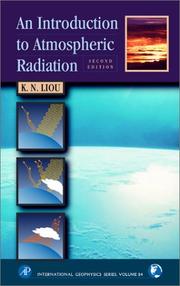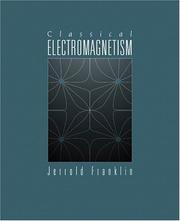| Listing 1 - 10 of 26 | << page >> |
Sort by
|
Book
ISBN: 3802301536 Year: 1981 Publisher: Würzburg Vogel-Verlag
Abstract | Keywords | Export | Availability | Bookmark
 Loading...
Loading...Choose an application
- Reference Manager
- EndNote
- RefWorks (Direct export to RefWorks)
warmteoverdracht --- warmtetransport --- konvektieverwarming --- condensatie --- verdampingswarmte --- straling --- (zie ook: warmtetransport) --- (zie ook: warmteoverdracht) --- Basic Sciences. Physics --- Thermodynamics.
Multi
ISBN: 9783031205101 9783031205095 9783031205118 9783031205125 Year: 2023 Publisher: Cham Springer International Publishing
Abstract | Keywords | Export | Availability | Bookmark
 Loading...
Loading...Choose an application
- Reference Manager
- EndNote
- RefWorks (Direct export to RefWorks)
Three-volumes book “Handbook of II-VI Semiconductor-Based Sensors and Radiation Detectors” is the first to cover both chemical sensors and biosensors and all types of photodetectors and radiation detectors based on II-VI semiconductors. It contains a comprehensive and detailed analysis of all aspects of the application of II-VI semiconductors in these devices. The second volume “Photodetectors” of a three-volume set, focus on the consideration of all types of optical detectors, including IR detectors, visible and UV photodetectors. This consideration includes both the fundamentals of the operation of detectors and the peculiarities of their manufacture and use. In particular, describes numerous strategies for their fabrication and characterization. An analysis of new trends in development of II-VI semiconductors-based photodetectors such as graphene/HgCdTe-, nanowire- and quantum dot-based photodetectors, as well as solution-processed, multicolor, flexible and self-powered photodetectors, are also given. Considers all types of photodetectors based on II-VI semiconductors; Features detailed analysis of all aspects of II-VI semiconductors applications; Maximizes reader understanding of the present status of II-VI semiconductors and their role in the development of next generation of photodetectors; Stands as an ideal reference for researchers concerned with electronics, optoelectronics, solar cells, electrical engineering, biomedical applications and a robust supplement for university students and faculty. .
Optics. Quantum optics --- Electronics --- Applied physical engineering --- halfgeleiders --- straling --- Optical detectors. --- Semiconductors.
Multi
ISBN: 9783031228711 9783031228704 9783031228728 9783031228735 Year: 2023 Publisher: Cham Springer International Publishing
Abstract | Keywords | Export | Availability | Bookmark
 Loading...
Loading...Choose an application
- Reference Manager
- EndNote
- RefWorks (Direct export to RefWorks)
This book addresses radiation protection of patients having digital radiography and computed tomography (CT) examinations. The literature on radiation doses to patients from these two modalities have reported that the doses to patients are high. As a result, the radiology community has focused on methods and procedures to keep these doses as low as reasonably achievable (ALARA) without compromising the diagnostic image quality. This book outlines the motivation for dose optimization in radiology, identifies and describes the ICRP principle of optimization, outlines the factors affecting the dose in digital radiography and in CT, and identifies and describes strategies used in digital radiography and in CT for dose optimization. This book is intended for all those working in digital radiography and CT environments including radiological technologists, and radiographers, radiologists, biomedical engineering technologists, and student medical physicists. It is best used as a supplement to radiologic science textbooks, and in particular, radiation protection textbooks. Furthermore, this book lays the foundations for students and practitioners engaged in research on dose reduction and dose optimization in radiology.
Optics. Quantum optics --- Physical methods for diagnosis --- radiologie --- medische beeldvorming --- straling --- Radiation dosimetry.
Multi
ISBN: 9789811919572 9789811919565 9789811919589 Year: 2022 Publisher: Singapore Springer Nature Singapore :Imprint: Springer
Abstract | Keywords | Export | Availability | Bookmark
 Loading...
Loading...Choose an application
- Reference Manager
- EndNote
- RefWorks (Direct export to RefWorks)
This book aims to explain radiation from a somewhat different aspect than its traditional image as something that is scary, dangerous, hazardous, and so on, to produce the correct understanding that radiation is carrying energy, and to convince readers that radiation is not "scary" but controllable and useful. As for radiation itself, many introductions or textbooks have been published, as in radiochemistry, radiobiology, and radiology. In most of them, the biological effects of radiation exposure are the main subjects, which often enhance the feeling that radiation is dangerous, and the effects produced by lower-dose exposure that are difficult to see are hardly discussed. The present volume mainly focuses on how radiation carries energy, how energy is absorbed in substances as absorbed doses (Gy) or dose equivalents (Sv), how damages or risks appear with the absorbed dose and why the effects of the exposure appear quite differently, depending on properties of the substances that were exposed.
Optics. Quantum optics --- Nuclear physics --- Human medicine --- fysica --- atoomfysica --- straling --- Radiation --- Radiation dosimetry. --- Measurement --- Physics --- Science

ISBN: 0124514510 9780124514515 9786611005443 1281005444 0080491677 9780080491677 Year: 2002 Volume: 84 Publisher: Amsterdam Boston Academic Press
Abstract | Keywords | Export | Availability | Bookmark
 Loading...
Loading...Choose an application
- Reference Manager
- EndNote
- RefWorks (Direct export to RefWorks)
This Second Edition of An Introduction to Atmospheric Radiation has been extensively revised to address the fundamental study and quantitative measurement of the interactions of solar and terrestrial radiation with molecules, aerosols, and cloud particles in planetary atmospheres. It contains 70% new material, much of it stemming from the investigation of the atmospheric greenhouse effects of external radiative perturbations in climate systems, and the development of methodologies for inferring atmospheric and surface parameters by means of remote sensing. Liou's comprehensive treatment
Atmosferische straling --- Atmospheric radiation --- Atmospheric transmission of infrared radiation --- Diffuse sky radiation --- Radiation [Atmospheric ] --- Radiation atmosphérique --- Sky radiation --- Straling [Atmosferische ] --- Atmospheric radiation. --- Global radiation. --- Radiation, Global --- Solar radiation --- Radiation, Atmospheric --- Electromagnetic waves
Book
ISBN: 9780123848734 0123848733 9780123848741 0123848741 1336202971 Year: 2012 Publisher: Amsterdam
Abstract | Keywords | Export | Availability | Bookmark
 Loading...
Loading...Choose an application
- Reference Manager
- EndNote
- RefWorks (Direct export to RefWorks)
The updated and much expanded 3e of the Handbook of Radioactivity Analysis is an authoritative reference providing the principles, practical techniques, and procedures for the accurate measurement of radioactivity from the very low levels encountered in the environment to higher levels measured in radioisotope research, clinical laboratories, biological sciences, radionuclide standardization, nuclear medicine, nuclear power, and fuel cycle facilities and in the implementation of nuclear forensic analysis and nuclear safeguards. The book describes the basic principles of radiation det
Nuclear physics --- nuclear radiation --- radioactiviteit --- straling --- Liquid scintillation counting --- Radioactivity --- Measurement --- Nuclear reactions --- Radiation --- Liquid scintillation counters --- Scintillation counting, Liquid --- Liquid scintillators --- Scintillation counters
Book
ISBN: 013197064X Year: 2005 Publisher: Upper Saddle River Pearson Education
Abstract | Keywords | Export | Availability | Bookmark
 Loading...
Loading...Choose an application
- Reference Manager
- EndNote
- RefWorks (Direct export to RefWorks)
Electromagnetism. Ferromagnetism --- 537.8 --- antenne --- elektromagnetisme --- elektrostatica --- magnetostatica --- straling --- Electromagnetism. Electromagnetic field. Electrodynamics. Maxwell theory --- Contains audio-visual material --- 537.8 Electromagnetism. Electromagnetic field. Electrodynamics. Maxwell theory --- Electromagnetism.

ISBN: 0805387331 Year: 2005 Publisher: San Francisco Pearson Addison Wesley Pearson Education
Abstract | Keywords | Export | Availability | Bookmark
 Loading...
Loading...Choose an application
- Reference Manager
- EndNote
- RefWorks (Direct export to RefWorks)
Electromagnetism. Ferromagnetism --- geleider --- magnetostatica --- elektrostatica --- ferromagneet --- magnetisch veld --- hysteresis --- elektromagnetisme --- wet van faraday --- elektromagnetische golf --- elektromagnetische straling --- relativiteitstheorie --- elektrodynamica --- quantummechanica --- Electromagnetism --- Electromagnetics --- Magnetic induction --- Magnetism --- Metamaterials
Book
ISBN: 9789001774332 Year: 2010 Publisher: Groningen Noordhoff Uitgevers
Abstract | Keywords | Export | Availability | Bookmark
 Loading...
Loading...Choose an application
- Reference Manager
- EndNote
- RefWorks (Direct export to RefWorks)
snelheid --- trillingen --- elektriciteit --- energie (technologie) --- optica --- beweging --- Physics --- fysica --- elektromagnetisme --- 5 --- Natuurkunde --- Elektriciteit --- Elektromagnetische straling --- elektromagnetische inductie --- natuurkunde (fysica) --- Wiskunde. Natuurwetenschappen --- Courses - Syllabuses --- 5 Wiskunde. Natuurwetenschappen --- departement Biotechniek 10 --- natuurkunde
Multi
ISBN: 9783030967987 9783030967970 9783030967994 9783030968007 Year: 2022 Publisher: Cham Springer International Publishing :Imprint: Springer
Abstract | Keywords | Export | Availability | Bookmark
 Loading...
Loading...Choose an application
- Reference Manager
- EndNote
- RefWorks (Direct export to RefWorks)
This book compiles and presents a complete package of open-access Python software code for luminescence signal analysis in the areas of radiation dosimetry, luminescence dosimetry, and luminescence dating. Featuring more than 90 detailed worked examples of Python code, fully integrated into the text, 16 chapters summarize the theory and equations behind the subject matter, while presenting the practical Python codes used to analyze experimental data and extract the various parameters that mathematically describe the luminescence signals. Several examples are provided of how researchers can use and modify the available codes for different practical situations. Types of luminescence signals analyzed in the book are thermoluminescence (TL), isothermal luminescence (ITL), optically stimulated luminescence (OSL), infrared stimulated luminescence (IRSL), timeresolved luminescence (TR) and dose response of dosimetric materials. The open-access Python codes are available at GitHub. The book is well suited to the broader scientific audience using the tools of luminescence dosimetry: physicists, geologists, archaeologists, solid-state physicists, medical physicists, and all scientists using luminescence dosimetry in their research. The detailed code provided allows both students and researchers to be trained quickly and efficiently on the practical aspects of their work, while also providing an overview of the theory behind the analytical equations.
Mathematical physics --- Quantum mechanics. Quantumfield theory --- Optics. Quantum optics --- Spectrometric and optical chemical analysis --- Programming --- IR spectroscopie --- quantumfysica --- theoretische fysica --- Python (informatica) --- wiskunde --- fysica --- straling --- Python (Computer program language) --- R (Computer program language)
| Listing 1 - 10 of 26 | << page >> |
Sort by
|

 Search
Search Feedback
Feedback About UniCat
About UniCat  Help
Help News
News